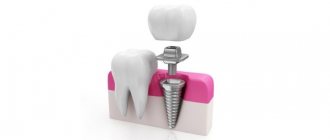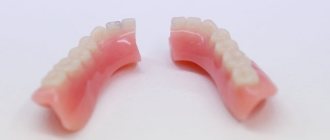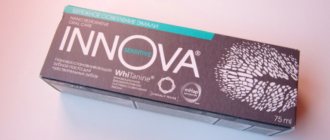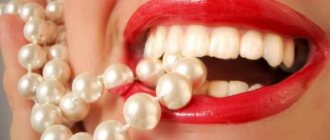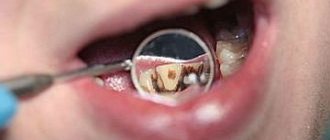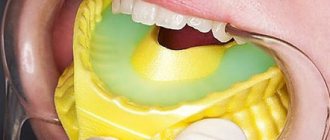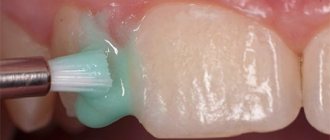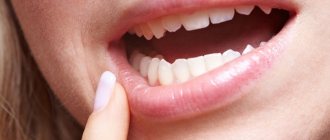The appearance of the dentition largely depends on the condition of the outer covering of the crowns - the enamel. It is a very hard substance, but like any other biological structure, it is vulnerable. Enamel can be destroyed under the influence of food components and negative environmental factors, but most often it suffers from poor hygiene.
When soft plaque consisting of bacteria accumulates on the surface of the tooth, the enamel is corroded by their waste products. Hard stones—mineralized plaque—cause even more damage. In both situations, tooth decay can be avoided by resorting to enamel restoration in the clinic or at home.
Structure and composition of dental tissues
The teeth on both jaws consist of three parts: the visible upper part - the crown, the root fixed in the socket and a short neck between them. Inside there is a pulp chamber with soft tissues, nerves and vessels that ensure continuity of life support for the entire tooth. This cavity is limited by dentin, a hard tissue that is covered with cement in the root area and enamel in the crown area.
The enamel on the surface of the tooth is distributed unevenly ; its layer reaches a maximum thickness of a couple of millimeters in those areas of the tooth where the greatest pressure is exerted on it. The molars, which are functionally responsible for grinding food, are abundantly covered with this tissue.
Unlike most tissues of the body, enamel contains much more inorganics: among the components there are the most calcium and phosphorus compounds, as well as fluorine. Organic substances are contained in small quantities, usually their content does not exceed 5%.
This composition is optimal for the enamel to be strong enough and resistant to chemical components of food. But after physical damage or corrosion by aggressive substances, the enamel on the teeth is not completely restored, which is why there are all kinds of ways to strengthen it and improve its condition.
Brief description of the problem
The enamel layer performs a protective function for dentin and pulp, which may be susceptible to pathogenic effects from microflora, as well as other types of irritants. Despite the fact that enamel is the strongest tissue present in the human body, it can be destroyed under the influence of acids and mechanical stress, losing the ability to prevent the occurrence of caries and other diseases of the oral cavity.
The tissue does not have the ability to recover on its own and its restoration must be carried out either in specialized clinics or at home, using the advice of traditional medicine.
Forms of dental hypoplasia
Carrying out measures to restore the protective layer of the tooth may be required in case of injuries and the development of carious processes, which lead to the penetration of microscopic organisms into the dental cavity, destroying dentin layers and can enter the pulp chamber. The described processes cause severe pain that cannot go unnoticed, however, in order to avoid such symptoms, it is enough to regularly undergo preventive examinations at the dentist. They contribute to the timely identification of problems that are quite simple to solve without the use of drastic measures.
Sectional structure of a tooth
Causes of tooth enamel destruction
For various reasons and at varying rates, damage to tooth enamel occurs throughout life. The intensity of its destruction does not always depend on the person himself, since the strength and thickness of the outer coating of the tooth is an innate feature. Even in the womb, the fetus may develop abnormalities in the structure of the dentition, which make the enamel more vulnerable.
Other factors that provoke the appearance of defects on the surface of the crown:
- The habit of opening bottle caps, nuts with the front teeth, biting off threads, biting nails, stationery, and seeds.
- Using a toothbrush with too hard bristles, paste or powder with large, hard abrasive components.
- Unsuccessful attempts to restore the whiteness of tooth enamel using folk remedies or in poor dental clinics with low quality services.
Lack of hygiene, which results in the accumulation of deposits on the crown and the development of caries.- Inadequate diet, which lacks the products necessary for the normal development of bone and dental tissues.
- Excess fluoride enters the body, which leads to the development of fluorosis with characteristic spots on the crown.
- Consumption of foods harmful to teeth: abuse of chocolate, sour fruits and berries, carbonated drinks.
- Metabolic failures in which the tissue does not receive sufficient nutrition.
- Removal of part of the dentition, after which the load on adjacent teeth increases and becomes uneven.
- Changes in the composition of saliva during hormonal imbalances, in women - during pregnancy.
- Smoking and injuries.
Bad habits
Bad habits are the most common cause of damage to tooth enamel. First of all, oral health is affected by smoking and alcoholism.
Yellowed teeth and bad breath are the most harmless companions of a smoker. Substances contained in tobacco smoke disrupt the functioning of the salivary glands, which negatively affects the mucous membrane.
Tobacco tars increase the thickness of the liquid in the mouth, and the liquid, in turn, washes the tooth enamel. Thus, the surface of the tooth is not washed thoroughly, plaque and cracks appear on the surface, which in the future can lead to caries and other dental diseases.
Alcohol not only has a detrimental effect on the digestive system as a whole, but also disrupts metabolic processes in the body.
Excessive or too frequent drinking of alcohol will cause a deficiency of calcium, which is part of tooth enamel.
Under the influence of strong drinks, teeth lose their natural whiteness and become a target for caries. The mucous membranes and gums also suffer due to the harmful effects of alcohol.
The seemingly harmless habit of biting pencils and nails can also lead to sad consequences.
Surely, many of us reflexively bite a pencil or pen during hard work or deep thoughtfulness.
This happens almost unconsciously, making it difficult to control the frequency and intensity of the habit.
Those who like to bite their nails too often put additional stress on the long-suffering enamel.
Symptoms and consequences
A person can find out that his enamel is damaged or thinned by the following symptoms:
- Increased sensitivity of teeth to the temperature of food, its composition and taste: shooting pain appears when eating very cold, hot, sour or sugary-sweet foods.
- Manifestation of tooth sensitivity when inhaling air through the mouth.
- Pain when chewing.
- Visible surface changes: the appearance of spots of various shades and shapes.
- Visible damage - chips, cracks.
If the enamel begins to thin, you need to determine the cause of the pathological process as quickly as possible. After all, for some patients it is enough to get rid of bad habits and adjust their diet so as not to aggravate the condition of the enamel, but for other patients this phenomenon may be a symptom of internal disorders that require urgent treatment.
If you ignore the condition of the enamel and do not try to restore it in the clinic or at least at home, the pathological process will move inside the tooth, which is fraught with the appearance of carious cavities with all possible complications.
Temperature changes and hidden infections
There is a popular belief that eating too hot or too cold foods affects the integrity of tooth enamel. Dentists cannot confirm or refute this thesis. The relationship between food temperature and the protective membrane of teeth has not been established.
The only thing we can say for sure is that teeth with already damaged enamel are extremely sensitive to temperatures. In this case, hot and cold foods will cause discomfort. It is fair to note that with damage to the enamel, unpleasant sensations can also occur when eating warm food.
Cracks and chips of tooth enamel create a favorable environment for the occurrence of hidden infections. Disruption of the natural microflora of the oral cavity only aggravates disease-causing processes.
The danger is that these diseases affect not only the teeth, but the gums and all the mucous membranes of the oral cavity.
With stomatitis, small ulcers appear on the inside of the patient’s cheeks, his tongue and the mucous membranes of the oral cavity. Ulcerative lesions are often accompanied by fever and depressed health.
Periostitis or “flux” is characterized by tissue suppuration due to caries.
The problem can only be solved surgically, since the abundance of pus in the oral cavity can lead to much more serious consequences than high fever and headache.
With periodontal disease and gingivitis, the patient’s gums are the first to suffer. They become inflamed, bleed and respond with pain to touch.
Restoration of tooth enamel in dentistry
In a dental clinic, tooth enamel can be restored using several methods:
| Method | The essence |
| Sealing | An old technique that eliminates enamel defects. Modern clinics use durable materials with a photo-curing effect. |
| Standard fluoridation | Periodic application of fluoride preparations to the crown. The procedure is carried out once every 6 months. The coating accumulates on the surface without reaching the deep layers of the tooth shells. |
| Deep fluoridation | Periodic coating of the crown with preparations containing fluoride and calcium. This procedure prevents oversaturation of the body with fluoride. |
| Remineralization | Periodic tooth restoration, which is carried out over a long period of time. Fluoride, calcium and some vitamins are applied to areas that have become thinner. |
| Implantation of artificial enamel for teeth | A mixture is used that, when implanted, firmly bonds with the tooth enamel. In appearance it is indistinguishable from a real crown. |
| Onlays for teeth | Plates made of metal-ceramics, ceramics or composite compounds, which are glued to the previously ground surface of the crown. More grinding of the tooth is necessary for the installation of veneers, less - for thin lumineers. Composite linings have the least strength and have a negative effect on natural enamel. |
How much do tooth enamel restoration procedures cost?
The cheapest methods of restoring the outer covering of a tooth are conventional filling and restoration using composite onlays. The most expensive ones are veneers and dental enamel implantation procedures.
| Procedure | How much does it cost (the exact amount depends on the materials used, the clinic, the degree of tooth decay and individual factors) |
| Sealing | From 2 to 7 thousand rubles. |
| Fluoridation | From 100 to 200 rub. for 1 procedure for 1 tooth |
| Remineralization | From 150 to 800 rub. for a complex procedure for 1 tooth |
| Implantation of artificial enamel | From 6 to 10 thousand rubles. |
| Overlays | From 2 to 50 thousand rubles. |
Is it worth going to the dentist?
Tooth enamel can be restored at home, but compared to professional restoration methods, folk ones are not as effective: large and deep damage cannot be repaired on your own . The main problem is that you first need to determine the cause of thinning enamel, which may be hidden in internal diseases, and only then decide on the optimal treatment methods.
Before trying folk advice and doing home procedures, you should consult a dentist, as the consequences can be unpredictable.
Innovative method
Dental enamel implantation is restoration at the molecular level. The procedure is currently considered the most effective and high-quality.
The technique consists of applying a special agent (an analogue of the protein amelogenin), which is part of the protective layer, to the surface of the problem unit.
During the process of damage, this substance is lost, so during implantation it is artificially supplied. After the procedure, the tooth returns to its former shape and even becomes more attractive. The implanted tissue does not differ in color from the natural one.
On a note! Recovery continues for about a month after the procedure, but the tissue is able to fully perform all the functions of tooth enamel immediately.
This result is achieved due to the formation of a crystal lattice after the protein enters the pores.
Indications for implantation will be the following conditions:
- darkening of the tooth (when other methods do not work);
- fluorosis;
- mechanical damage;
- pathological bite (mild severity);
- irregular crown shape;
- large interdental spaces.
On a note! The procedure is a minimally invasive method and therefore does not require pain relief, which significantly narrows the list of contraindications.
The video shows the process of dental enamel implantation.
How to restore tooth enamel at home and with folk remedies
Among home and folk methods that help partially restore enamel, restore normal appearance and remove discomfort from hypersensitivity, the most popular are the following:
- Improving your diet.
- Regular massage of the gums, which is carried out with the fingertips and is needed to intensify blood circulation and nourish the tissues.
- Using fluoride-containing restorative toothpastes that strengthen the enamel and prevent its further destruction. When brushing, the paste must be left in the mouth for at least three minutes so that the necessary components have time to be absorbed into the dental tissues.
- The use of toothpastes with triclosan and copolymer - substances that provide temporary protection against the accumulation of soft plaque and its degeneration into tartar.
- Mouth guard with gel
Restoring tooth enamel at home can be done using special therapeutic trays with fluoride-containing gel, which promote the regeneration of hard tooth tissues.
- Some herbs help restore normal tissue nutrition: mint, fennel, cinnamon. A mixture of this ground raw material is used to clean teeth.
- If the enamel has become thin and sensitive, you can chew beeswax a couple of times a week.
Products for strengthening enamel
Tooth enamel is practically incapable of self-regeneration, but it can be replenished with nutritional components of food and thus strengthened. If these nutrients are present in the diet, the risk of abrasion or destruction of the outer shell of the tooth is reduced. Therefore, we must not forget about healthy foods that saturate teeth with essential substances.
| Essential component for dental tissues | What products contain |
| Calcium | Dairy products, ground eggshells, eggs, almonds, sesame seeds, bananas. |
| Phosphorus | Dairy, peanut butter, grains, garlic, legumes. |
| Fluorine | Drinking water, tea, sea fish. |
| Vitamin C | Citrus fruits (in reasonable quantities), rose hips, sweet peppers, strawberries, currants. |
| Vitamin D | Red caviar, fish, beef liver, eggs. |
Folk recipes
The pantries of traditional medicine are replete with remedies for all occasions. Among them there are truly effective ways to restore tooth enamel at home and at the same time strengthen the health of your teeth.
Advantages of traditional medicine over official medicine:
- no side effects;
- availability of ingredients;
- savings in price.
Restoring tooth enamel at home using folk remedies is only relevant in cases where it is slightly damaged. For more severe damage, be sure to contact a dentist.
Sea salt perfectly eliminates damage to tooth enamel. Dissolve one tablespoon of salt in a glass of warm water.
Rinse your teeth with the resulting solution every day before going to bed.
While rinsing, it is useful to hold the solution in your mouth for several minutes, this will enhance the healing effect.
A week after you start rinsing, you will notice changes in the condition of your teeth. In some recipes, a spoonful of vegetable oil is added to the saline solution.
Read also: Means for restoring tooth enamel
A solution of propolis extract will restore lost strength to the enamel. Add 10 drops of this product to a glass of warm water and rinse your mouth with the resulting mixture regularly.
Rinsing should be done daily, morning and evening, for a week. If you skip a day of rinsing, the healing effect may not occur.
Some traditional medicine doctors say that calamus tincture enhances the healing properties of propolis.
A solution of these components relieves toothache and restores worn enamel. Add 50 ml of calamus tincture to the above recipe and rinse according to the already familiar pattern.
Herbs can not only strengthen the enamel, but also change its color. The following recipe will be especially relevant for smokers or those people whose teeth have lost their natural whiteness.
Hold it for a couple of minutes.
Then rinse your mouth with a solution of soda in the following proportions: half a teaspoon of soda per glass of warm water.
Garlic and beetroot compresses also help lighten tooth enamel.
Chop the garlic and beets, then mix in equal parts and apply to the gums. The compress must be kept for a couple of minutes, then rinsed with a solution of water and soda.
Dentists' recommendations
Tooth enamel can be restored both in the clinic and at home, but a very important part of this process lies in the behavior of the person himself. To maintain oral health, you should always take care of yourself, notice bad habits in time and immediately stop them. Adults should control children's behavior and teach them basic hygiene.
You can prevent thinning of the enamel by following these recommendations:
- You should protect your teeth from any unnecessary physical impact, including your habits of opening bottles with them and biting off threads. Injury should be avoided whenever possible.
- Food should be moderately hard; you should not overuse soft foods, as fibrous fruits help remove plaque.
- You should not allow sudden changes in temperature, for example, drinking chilled ice cream with hot coffee.
- The habit of brushing your teeth should be formed from childhood and done regularly. If you skip this hygiene procedure a couple of times, all the accumulated soft plaque will mineralize and become hard dental plaque that destroys the tooth coating.
- There should not be an excess of sweets in the diet, and after each use it is advisable to rinse your mouth with water or restorative pharmaceutical products.
Tooth enamel regenerates naturally, but if this tissue is destroyed or worn away, it does not regenerate on its own. Therefore, a person must take care of the health of his teeth throughout his life, strengthen the enamel and try not to harm it.
If you carry out tooth enamel restoration in dentistry or follow popular advice, you can significantly improve the structure and appearance of crowns. In case of severe damage, it is possible to eliminate defects in the front teeth by installing artificial implants and onlays. If the enamel is destroyed quickly and very strongly, it is imperative to look for the cause of the pathology.
Do you need a strengthening diet for teeth?
In everyday life, it is important to adhere to an anti-caries diet. This diet involves limiting the consumption of sweets and, in particular, sugary drinks. The menu should be dominated by solid, granular, even fibrous foods.
A restorative diet for enamel involves increasing the calcium content in the daily menu. If there are no other health contraindications, it is recommended to increase the consumption of milk and dairy products, such as white cheese and natural yogurt.
Let's enamel your teeth! Well, is this possible?
Enamel is the protective shell of teeth. This hard tissue is exposed to all kinds of stress and harmful influences throughout life: excessive pressure when eating, the influence of food acids, sugar, temperature changes.
She is also sensitive to staining when drinking strong tea, coffee, red wine, and cigarettes. To protect this shell from destruction and preserve its natural snow-whiteness, there are many means, both modern medical and folk.
Read also: Tooth enamel is restored
